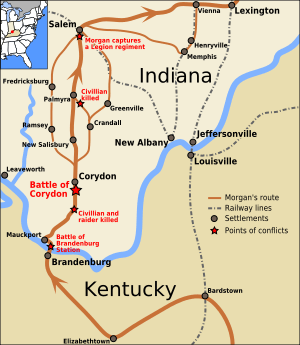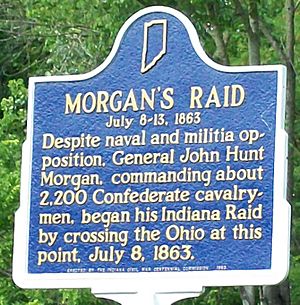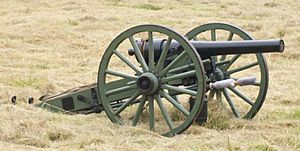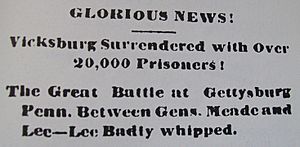Battle of Corydon facts for kids
Quick facts for kids Battle of Corydon |
|||||||
|---|---|---|---|---|---|---|---|
| Part of the American Civil War | |||||||
 Map showing Morgan's Raid in the Harrison and Washington County area, and the location of the battle. |
|||||||
|
|||||||
| Belligerents | |||||||
| Commanders and leaders | |||||||
| John H. Morgan | Lewis Jordan | ||||||
| Units involved | |||||||
| Morgan's Cavalry Division | Indiana Legion | ||||||
| Strength | |||||||
| 1,800 4 artillery pieces |
400–450 | ||||||
| Casualties and losses | |||||||
| 11 killed1 40 wounded3 |
4 killed2 10–12 wounded 355 captured |
||||||
|
1One additional Confederate was killed by a civilian before the battle began 2Three civilians were killed by Confederates. Two Legion defenders were also killed during the crossing of the Ohio River the day before the battle. 3One Confederate was wounded during the crossing of the Ohio River |
|||||||
The Battle of Corydon was a small but important fight during the American Civil War. It happened on July 9, 1863, near Corydon, Indiana. Corydon was once the capital of Indiana and is the main town of Harrison County. This battle was part of Morgan's Raid, where about 2,500 Confederate cavalry soldiers rode into the North. It was the only major battle of the Civil War fought in Indiana.
As news of the raid spread, Indiana's Governor, Oliver P. Morton, called up the state's volunteer army, called the Indiana Legion. About 100 Legion soldiers tried to stop the Confederates from crossing the Ohio River into Indiana. But the Confederates had stronger cannons and forced the Legion to retreat. Two Legion soldiers died during this river crossing. The Legion then joined with more local defenders in Corydon. They quickly built a defensive line south of the town. Even though they hoped for more help, only about 450 local men were ready to defend Corydon.
When the Confederate raiders arrived, they attacked the Legion's defenses. They tried a direct attack and a move around the side. Soon, more Confederate troops and cannons arrived, giving them a huge advantage. With cannon fire and a "pincer movement" (attacking from both sides), the Legion had to leave their positions to avoid being surrounded. Many Legion soldiers were captured as they tried to escape. Colonel Lewis Jordan, who led the Legion, and others gathered in downtown Corydon. The Confederates then took supplies and fired warning shots into the town. Colonel Jordan realized it was hopeless and surrendered Corydon. Even though the Confederates had more losses, they won the battle. This allowed their leader, Brigadier General John H. Morgan, to get supplies and money. However, the battle caused a delay, which helped the Union army catch up to Morgan and eventually capture him.
Contents
Why Did the Battle of Corydon Happen?
After a smaller raid in Indiana in 1862, the government sent regular cavalry troops to southern Indiana. But when no more raids happened, these troops left in March 1863. This meant only local volunteer soldiers were left to defend the area.
Morgan's Ride Through Kentucky
On June 23, 1863, Brigadier General John H. Morgan led about 2,500 cavalry soldiers and four cannons from Tennessee. His goal was to disrupt Union communications in Kentucky. This was meant to help the main Confederate army. Morgan had orders not to cross the Ohio River into Union territory. But he planned to ignore these orders and had already sent scouts ahead.
Morgan's men used telegraph lines to send false messages about their plans. Most Union officials thought Morgan was heading to Louisville, Kentucky. To be safe, Indiana's Governor Oliver P. Morton ordered all Indiana Legion units south of the National Road to be ready.
On July 7, an advance group of Confederates entered Brandenburg, Kentucky. They captured two steamships, the John T. McCombs and the Alice Dean. These ships were needed to ferry Morgan's large force across the wide Ohio River.
The Fight at Brandenburg Crossing
Indiana militia leaders soon learned that Morgan was in Brandenburg and planned to cross into Indiana. All the roads Morgan would likely take led to Corydon. Urgent requests for help were sent out. Three companies of the 6th Regiment Indiana Legion, about 100 men, went to Morvin's Landing. This was on the Indiana side of the river, across from Brandenburg. A small group from the 8th Regiment also arrived with a cannon.

On the morning of July 8, the Legion tried to fire their cannon at the Confederate ships. But they weren't very good at aiming. The Confederates quickly set up their own cannons on the Kentucky side. They were in a higher position and fired back. Their shots hit near the Legion, forcing them to run into a nearby forest. Two Legion defenders were badly wounded and later died.
With the Indiana defenders gone, Morgan began moving his troops across the river using the captured steamships. A Union gunboat, the Springfield, arrived and started firing at Morgan's ships. The Confederate cannons fired back, and the two sides exchanged fire for about an hour. The Springfield eventually ran out of ammunition and left. This allowed Morgan to continue crossing.
Later, two more Union ships arrived, but they were wooden and quickly retreated when the Confederate cannons opened fire. It took Morgan 17 hours to get his 2,000 men and supplies across the river. He learned that a Union force of 4,000 cavalry was close behind him. Once all his men were across, Morgan ordered the Alice Dean to be burned and sunk to block the river. The other ship was spared. Union General Edward H. Hobson and his troops arrived in Brandenburg around 10:15 p.m., just as the Alice Dean sank. Morgan's forces quickly moved north towards Corydon.
The Battle of Corydon: What Happened?
Small Fights Before the Main Battle
As Morgan's troops moved closer to Corydon, they had some small skirmishes. The Indiana Legion managed to capture 16 Confederates in an ambush. The Confederates also captured about 30 Legion defenders. Morgan released these prisoners after they promised to go home and not fight again.
That night, Morgan's men camped near Mauckport. They found the area empty, as civilians had fled. Morgan's men again tapped into telegraph lines. They sent false messages saying they were heading to Indianapolis. This trick stopped New Albany from sending many reinforcements to Corydon. The next morning, as the Confederates continued their march, a shot was fired from a house, killing a Confederate soldier. The Confederates fired back, killing a minister and wounding his son.
Corydon was the main town of Harrison County and used to be Indiana's capital. The townspeople had worked all night building a barricade of logs on a ridge south of town. Confederate spies had already reported this to Morgan. The Legion took positions behind these defenses. Many older men joined the defense, bringing their numbers to about 450. Despite urgent calls for help, no more reinforcements arrived before the battle.
The Attack on Corydon
The Legion's barricade was about 4 to 5 feet high (1.5 meters). It stretched for about 2,500 feet (760 meters) across the main roads leading into Corydon. Colonel Lewis Jordan, a veteran of the War of 1812, led the 6th Regiment of the Indiana Legion. Most of his men had never fought in a battle before.
At 11:30 a.m. on July 9, the first Confederate soldiers were seen moving towards Corydon. Morgan decided his advance forces should attack the Legion.
Around noon, the Confederates formed a line and began to attack. They tried a direct attack on the western side, which was wooded. They were pushed back three times. At the same time, Confederates tried to go around the eastern side of the defenses. Thirty Legion soldiers on that side had special Henry rifles that could fire 14 shots quickly. They managed to hold off the Confederates for about 20 minutes.
Soon, more Confederate regiments arrived, giving them more soldiers than the Legion. Around 12:40 p.m., Confederate cannons arrived. They used two powerful Parrott rifle cannons to pin down the defenders. Meanwhile, General Morgan led his main troops around the eastern side of the defenses, heading straight for the town. They shot and robbed a toll gate keeper who refused to drop his gun.
The Legion Retreats
With the cannons firing and Confederates trying to surround them, Colonel Richard Morgan (the general's brother) launched a "pincer movement." This meant attacking from both sides to trap the Legion. Colonel Lewis Jordan ordered his men to retreat to avoid being captured. The Confederates, with their greater numbers, quickly turned the retreat into a full rout. The second part of the battle lasted about 25 minutes, making the whole battle about an hour long. As the Legion fled into town, many threw their guns into Indian Creek so the enemy couldn't get them. About 100 men tried to escape on the main road, but they were captured because the main Confederate force was already there.
A large part of the Legion, including Colonel Jordan, retreated into downtown Corydon. On the edge of town, Confederates took the Legion's supplies. General Morgan then took control of the high ground south of town. He fired two warning shots from his cannons into Corydon. One shot landed near the Kintner-McGrain House, which is now a historic site. Colonel Jordan realized that fighting more was useless. He didn't want to see more lives lost, so he quickly surrendered the town by raising a white flag. The Legion's cavalry and mounted soldiers escaped, but most of the remaining foot soldiers were captured.
Reports on casualties vary. The most reliable information suggests the Legion lost 4 killed, 10 to 12 wounded, and 355 captured. About 100 escaped. Morgan's raiders had 11 killed and 40 wounded. Three civilians were also killed.
What Happened After the Battle?
Corydon is Plundered
Morgan led his soldiers into Corydon. A county official was shot and killed as he left the courthouse with a rifle. Morgan "paroled" the captured Legion soldiers, meaning they promised not to fight again for a certain time. Their weapons were taken or destroyed. Prisoners in the county jail, including the Confederates captured earlier, were freed.
Morgan's cavalry spent the afternoon stealing from stores and collecting "ransom money." Morgan threatened to burn three local mills unless they paid $1,000 each. The owners negotiated it down to $500. The county treasurer paid $690 to save the courthouse from being burned. Two large stores paid $600 each. Morgan's men also robbed townspeople, taking everything from ice skates to horses. The total amount taken was about $26,450. Most of the stolen goods and damage were later paid back by the state government.
Morgan ate lunch at the Kintner House Inn. There, he read a newspaper and learned that the Confederates had lost at Gettysburg and Vicksburg. This news made him realize his army was in serious danger. He had planned to meet the Confederate army in Pennsylvania, but that was now impossible. He began to plan his escape back across the Ohio River. He had his telegrapher send false messages saying he was heading to Indianapolis to free Confederate prisoners. The Confederate dead were buried in unmarked graves. Morgan's wounded were left in a local church and cared for. They were later released when Union troops arrived.
Morgan's Raid Continues
After looting Corydon, parts of Morgan's force left and continued to search the countryside for fresh horses and food. An African American from Corydon was forced to guide them for two days before he escaped. By 6:00 p.m., Morgan and his main group had resumed their march north. They camped near New Salisbury before leaving Harrison County the next morning.
As soon as Governor Morton learned of the defeat at Corydon, he demanded that two Indiana regiments be sent back from Louisville, Kentucky. The Union commander refused but ordered his cavalry to chase Morgan. The defeat at Corydon was symbolic because it had been the state capital.
More than 150,000 men joined Legion units in the next week to pursue Morgan. General Hobson and his Union troops arrived in Corydon on July 10. Even though it was a Confederate victory, the Battle of Corydon had delayed Morgan by six crucial hours. This allowed the Union army to start catching up. Soon, 6,000 Union cavalry were only a few miles behind him. Morgan briefly continued north and raided Salem. Then he turned east towards Ohio, trying to escape. He was stopped at the Battle of Buffington Island when he tried to cross the Ohio River. Only about 250 of his men got across before Union gunboats stopped him. Morgan was later captured at the Battle of Salineville, the furthest north regular Confederates ever reached.
Other small fights happened in Indiana during the war, but the Battle of Corydon was the only major battle fought in the state. It remains the last military conflict to have occurred in Indiana. In 1976, the battle site was made into the Corydon Battle Site memorial park. It was added to the National Register of Historic Places in 1979. Today, it is part of the John Hunt Morgan Heritage Trail. The battle has been re-enacted every year since 1980.
Images for kids
-
12 lb howitzer cannon like the one used in the battle









